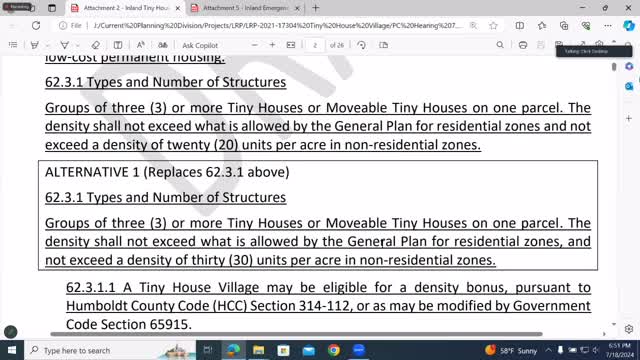Housing Density Debate Sparks Push for More Affordable Units
July 19, 2024 | Humboldt County, California

This article was created by AI summarizing key points discussed. AI makes mistakes, so for full details and context, please refer to the video of the full meeting. Please report any errors so we can fix them. Report an error »

In a recent government meeting, officials discussed the potential increase of housing density from 20 to 30 units per acre, aiming to address the growing demand for affordable housing. The conversation highlighted the necessity of maximizing unit numbers to ensure financial viability for developers, as lower rents require a greater volume of units to cover costs.
Commissioners expressed support for the proposed increase, noting that the original recommendation of 20 units per acre was based on earlier research but had shifted in light of new findings regarding density bonus laws. The discussion emphasized that a higher density could incentivize the development of more affordable housing options, aligning with state trends and community needs.
One commissioner referenced successful projects, such as Emerald Village by Square 1, which demonstrated the feasibility of achieving 20 units per acre. However, there were concerns about the practical challenges of reaching 30 units per acre, particularly regarding the spatial requirements for parking and common areas in horizontal developments.
Overall, the meeting underscored a collective push towards increasing housing density as a strategy to enhance affordability and meet the housing crisis head-on, with a recommendation to adopt the 30 units per acre guideline moving forward.
Commissioners expressed support for the proposed increase, noting that the original recommendation of 20 units per acre was based on earlier research but had shifted in light of new findings regarding density bonus laws. The discussion emphasized that a higher density could incentivize the development of more affordable housing options, aligning with state trends and community needs.
One commissioner referenced successful projects, such as Emerald Village by Square 1, which demonstrated the feasibility of achieving 20 units per acre. However, there were concerns about the practical challenges of reaching 30 units per acre, particularly regarding the spatial requirements for parking and common areas in horizontal developments.
Overall, the meeting underscored a collective push towards increasing housing density as a strategy to enhance affordability and meet the housing crisis head-on, with a recommendation to adopt the 30 units per acre guideline moving forward.
View full meeting
This article is based on a recent meeting—watch the full video and explore the complete transcript for deeper insights into the discussion.
View full meeting
